
The Clinton–Kalamazoo Canal is a canal in Michigan that was abandoned after being only partially completed. The canal was to connect Lake St. Clair with Lake Michigan. Project backers were inspired by the success of the Erie Canal in New York, which was completed in 1825. After gaining statehood in 1837, Michigan elected its first governor, Stevens Thomson Mason, who initiated an ambitious program of internal improvements, including three railroads and two canals. On March 21, 1837, the Legislature authorized Governor Mason to contract a loan for the construction of the canal from Mt. Clemens to Rochester, a railroad from Shelby to Detroit, a railroad from Detroit across the State and a railroad from Port Huron into the interior, to be known as the Port Huron & Grand River road. In the spring of 1838, a Board of Commissioners composed of seven men, was appointed to take charge of the canal work.
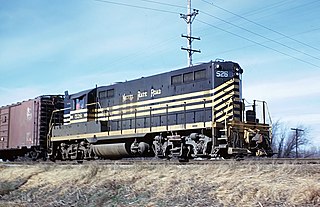
The New York, Chicago and St. Louis Railroad, abbreviated NYC&St.L, was a railroad that operated in the mid-central United States. Commonly referred to as the Nickel Plate Road, the railroad served a large area, including trackage in the states of New York, Pennsylvania, Ohio, Indiana, Illinois and Missouri. Its primary connections included Buffalo, Chicago, Cincinnati, Cleveland, Indianapolis, St. Louis, and Toledo.

The Cincinnati and Lake Erie Railroad (C&LE) was a short-lived electric interurban railway that operated in 1930–1939 Depression-era Ohio and ran between the major cities of Cincinnati, Dayton, Springfield, Columbus, and Toledo. It had a substantial freight business and interchanged with other interurbans to serve Detroit and Cleveland. Its twenty high-speed "Red Devil" interurban passenger cars operated daily between Cincinnati and Cleveland via Toledo, the longest same equipment run by an interurban in the United States. The C&LE failed because of the weak economy and the loss of essential freight interchange partners. It ceased operating in 1939.
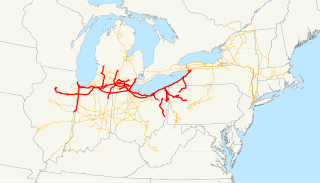
The Lake Shore and Michigan Southern Railway, established in 1833 and sometimes referred to as the Lake Shore, was a major part of the New York Central Railroad's Water Level Route from Buffalo, New York, to Chicago, Illinois, primarily along the south shore of Lake Erie and across northern Indiana. The line's trackage is still used as a major rail transportation corridor and hosts Amtrak passenger trains, with the ownership in 1998 split at Cleveland between CSX to the east, and Norfolk Southern in the west.
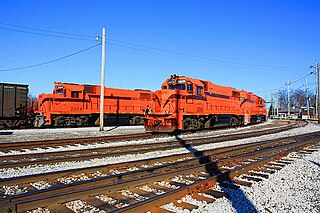
The Chicago South Shore and South Bend Railroad, also known as the South Shore Line, is a Class III freight railroad operating between Chicago, Illinois, and South Bend, Indiana. The railroad serves as a link between Class I railroads and local industries in northeast Illinois and northwest Indiana. It built the South Shore Line electric interurban and operated it until 1990, when it transferred it to the Northern Indiana Commuter Transportation District. The railroad is owned by the Anacostia Rail Holdings Company.
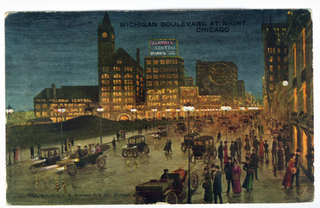
Central Station was an intercity passenger terminal in downtown Chicago, Illinois, at the southern end of Grant Park near Roosevelt Road and Michigan Avenue. Owned by the Illinois Central Railroad, it also served other companies via trackage rights. It opened in 1893, replacing Great Central Station, and closed in 1972 when Amtrak rerouted services to Union Station. The station building was demolished in 1974. It is now the site of a redevelopment called Central Station, Chicago.

The Duluth, South Shore and Atlantic Railway (DSS&A) was an American railroad serving the Upper Peninsula of Michigan and the Lake Superior shoreline of Wisconsin. It provided service from Sault Ste. Marie, Michigan, and St. Ignace, Michigan, westward through Marquette, Michigan to Superior, Wisconsin, and Duluth, Minnesota. A branchline stretched northward from Nestoria, Michigan up to the Keweenaw Peninsula and terminating at Houghton, Michigan, with two branches extending further to Calumet, Michigan and Lake Linden, Michigan.

The Lake Superior and Ishpeming Railroad, a U.S. railroad offering service from Marquette, Michigan, to nearby locations in Michigan's Upper Peninsula, began operations in 1896. The LS&I continues to operate as an independent railroad from its headquarters in Marquette.

The Detroit and Toledo Shore Line Railroad is a historic railroad that operated in northwestern Ohio and southeastern Michigan.
The Detroit Connecting Railroad Company is a Class III shortline railroad owned by the Adrian and Blissfield Rail Road Company. Its freight operations began in December 1998 with 2.25 miles (3.62 km) of track.
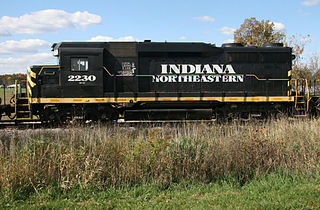
The Indiana Northeastern Railroad is a Class III short line freight railroad operating on nearly 130 miles (210 km) in southern lower Michigan, northeast Indiana and northwest Ohio. The Indiana Northeastern Railroad Company began operations in December 1992 and is an independent privately owned company. As of 2017 the railroad hauled more than 7,000 carloads per year. Commodities moved by the railroad include corn, soybeans, wheat and flour. It also handles plastics, fiberboard, aluminum, copper, coal, perlite, stone, lumber, glass, rendering products, as well as agricultural fertilizers and chemicals.

The Detroit United Railway was a transport company which operated numerous streetcar and interurban lines in southeast Michigan. Although many of the lines were originally built by different companies, they were consolidated under the control of the Everett-Moore syndicate, a Cleveland-based group of investors. The company incorporated on December 31, 1900, and continued to expand into the early 1920s through new construction and the acquisition of smaller concerns. After the DUR acquired the Detroit-Jackson line in 1907, it operated more than 400 miles (640 km) of interurban lines and 187 miles (301 km) of street city street railway lines.

The Chicago, Kalamazoo and Saginaw Railway (CK&S), known informally as the "Cuss, Kick & Swear" is a defunct railroad which operated in southwest Michigan in the late 19th and early to mid 20th centuries. Despite the name, the line ran entirely within the state of Michigan, with the majority in Kalamazoo County. It eventually became part of the New York Central. As of 2010, most of the former CK&S tracks have since been abandoned.
Michigan United Railways (MUR) was an interurban which owned and leased numerous lines in the state of Michigan during the early twentieth century.

Samuel Floyd Angus was an American business owner and professional sports team owner. He was the principal owner of the Detroit Tigers of the American League from November 1901 through October 1903.
Milwaukee Junction is an area in Detroit, Michigan, east of New Center. Located near the railroad junction of the Grand Trunk Western Railroad's predecessors Detroit, Grand Haven and Milwaukee Railway and the Chicago, Detroit and Canada Grand Trunk Junction, the area encompasses the streets of East Grand Boulevard to the north, St. Aubin St./Hamtramck Drive to the east, John R Street to the west, and the border following I-94 to the south. Due to the presence of numerous car companies within it at the turn of the 20th century, Milwaukee Junction is considered the "cradle of the Detroit auto industry".
The CSX Saginaw Subdivision is a railroad line in the U.S. state of Michigan. The line runs 105 miles from Toledo, Ohio to Saginaw, Michigan; although since 2006, the section from Mt. Morris to Saginaw has been leased to the Lake State Railway, but is still occasionally used by CSX.

Interurban and streetcar railways flourished in Syracuse, New York until the automobile, airplane and bus took their place.
















